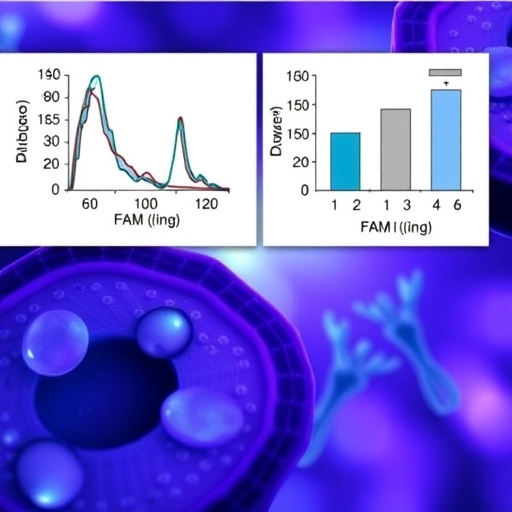In a groundbreaking study published in BMC Cancer, researchers have unveiled a pivotal molecular mechanism that could reshape therapeutic approaches to ovarian cancer—a disease notoriously challenging both in diagnosis and treatment due to its aggressive nature and high mortality rate. The study zeroes in on FAM111B, a gene whose functional role in ovarian cancer has remained largely enigmatic until now, illuminating its intimate connection with tumor development and progression through modulation of the MYC oncogene.
Ovarian cancer stands as one of the deadliest gynecological malignancies worldwide, largely due to its asymptomatic early stages and frequent late-stage diagnoses. With current treatments failing to achieve substantial survival improvements, identifying novel molecular targets is imperative. The research spearheaded by Yu, Wei, Li, and their colleagues marks a significant advance by elucidating how knocking down FAM111B impairs multiple cancer-promoting processes in ovarian cancer, effectively curbing tumorigenesis.
Using two well-established ovarian cancer cell lines, ES2 and A2780, the researchers conducted a series of systematic knockdown experiments targeting FAM111B expression. Their observations revealed a remarkable attenuation in cellular proliferation, migration, and invasion capabilities—hallmarks of aggressive cancer phenotypes. Furthermore, the reduction of FAM111B influenced the epithelial-mesenchymal transition (EMT), a crucial process enabling cancer cells to acquire invasive and metastatic properties, highlighting FAM111B’s broad regulatory role in cancer cell plasticity.
Extending beyond cell cultures, the team developed a mouse xenograft model to investigate the consequences of FAM111B silencing in vivo. Consistently, mice injected with ovarian cancer cells deficient in FAM111B exhibited significantly suppressed tumor growth, underscoring the gene’s functional importance in sustaining ovarian tumorigenesis within a living organism. This in vivo validation represents a critical step toward the translational potential of targeting FAM111B in clinical settings.
Histopathological analyses further reinforced the clinical relevance of FAM111B. Using tissue microarrays from patients diagnosed with serous ovarian cancer, the team conducted immunohistochemical staining which indicated that elevated FAM111B protein levels strongly correlated with poor prognostic outcomes. This evidence not only positions FAM111B as a biomarker for malignancy severity but also as a potential predictive marker for patient stratification in future therapies.
At the molecular level, the study unveiled that the tumor-promoting activities governed by FAM111B are closely linked to the regulation of MYC, a well-known oncogene implicated in numerous cancers. Silencing FAM111B triggered a notable downregulation of MYC expression, which mechanistically underpins the impaired cancer phenotypes observed. To definitively establish the connection, rescue experiments were performed wherein MYC was overexpressed despite FAM111B knockdown, effectively reversing the inhibitory effects on proliferation, migration, and invasion. This critical experiment provides robust causative evidence positioning MYC as a downstream effector of FAM111B.
Protein-level transcriptomic analyses lent further support by identifying that FAM111B influences key genetic-information processing pathways through MYC. These findings accentuate the gene’s pivotal regulatory axis and hint at a complex signaling network where FAM111B modulates transcriptional programs that favor tumor growth and metastasis. Such insights deepen our molecular understanding of ovarian cancer biology and open new avenues for targeted interventions.
The implications of targeting FAM111B extend beyond therapeutic potential. Given its prognostic significance evidenced in patient samples, FAM111B could serve as a valuable biomarker aiding early detection and risk stratification. Integrating FAM111B expression profiles into clinical workflows might refine patient management, allowing more personalized and effective treatment regimens that improve survival outcomes.
Ovarian cancer’s inherent heterogeneity has impeded the identification of universally effective treatments. By uncovering a novel and actionable gene target, this research offers hope for overcoming these obstacles. Targeted therapies following FAM111B suppression could disrupt the tumor’s proliferative and invasive machinery, potentially enhancing responses to conventional chemotherapies and reducing resistance.
Moreover, the study’s methodological rigor, combining in vitro models, animal studies, and patient tissue analyses, provides a comprehensive validation pipeline. Such multifaceted approaches are critical in oncological research, ensuring findings are robust, reproducible, and clinically relevant. This work sets a benchmark for future investigations exploring gene-function dynamics in cancer pathogenesis.
While the precise biochemical mechanism through which FAM111B regulates MYC remains to be fully elucidated, this research delivers compelling evidence of a direct functional relationship. Further research dissecting the molecular interactions and downstream pathways may reveal additional druggable targets and refine strategies to inhibit this oncogenic axis.
These discoveries echo the broader trend in cancer biology emphasizing the role of genes traditionally underexplored in cancer research. FAM111B exemplifies how “hidden” genes within the human genome may harbor significant oncogenic potential, and their characterization could revolutionize cancer diagnosis and treatment paradigms.
The convergence of bioinformatics, proteomics, and experimental oncology in this study reflects the changing landscape of cancer research, where integrative and interdisciplinary approaches yield transformative insights. As more layers of gene regulation in cancer are unraveled, comprehensive molecular profiles such as those involving FAM111B and MYC will likely inform next-generation precision oncology.
In concluding, this seminal work not only adds a new player—FAM111B—to the ovarian cancer molecular tapestry but also highlights the therapeutic promise of targeting gene expression regulatory pathways. It paves the way for novel interventions that can attenuate the otherwise relentless progression of ovarian tumors.
Given ovarian cancer’s global impact and the pressing need for improved interventions, the identification of FAM111B as both a biomarker and a therapeutic target offers a beacon of hope. Continued research focusing on this gene and its molecular network could ultimately translate to enhanced patient survival and better quality of life.
This study poignantly underscores a fundamental paradigm: disrupting oncogene regulatory circuits through targeted gene silencing can yield profound antitumor effects. Translating such insights from bench to bedside remains a vital frontier in the quest to conquer ovarian cancer.
Subject of Research: The role and therapeutic potential of the FAM111B gene in ovarian cancer tumorigenesis and its regulatory relationship with the MYC oncogene.
Article Title: FAM111B knockdown attenuates tumorigenesis of ovarian cancer via the downregulation of MYC
Article References:
Yu, G., Wei, F., Li, W. et al. FAM111B knockdown attenuates tumorigenesis of ovarian cancer via the downregulation of MYC. BMC Cancer 25, 1290 (2025). https://doi.org/10.1186/s12885-025-14740-6
Image Credits: Scienmag.com




